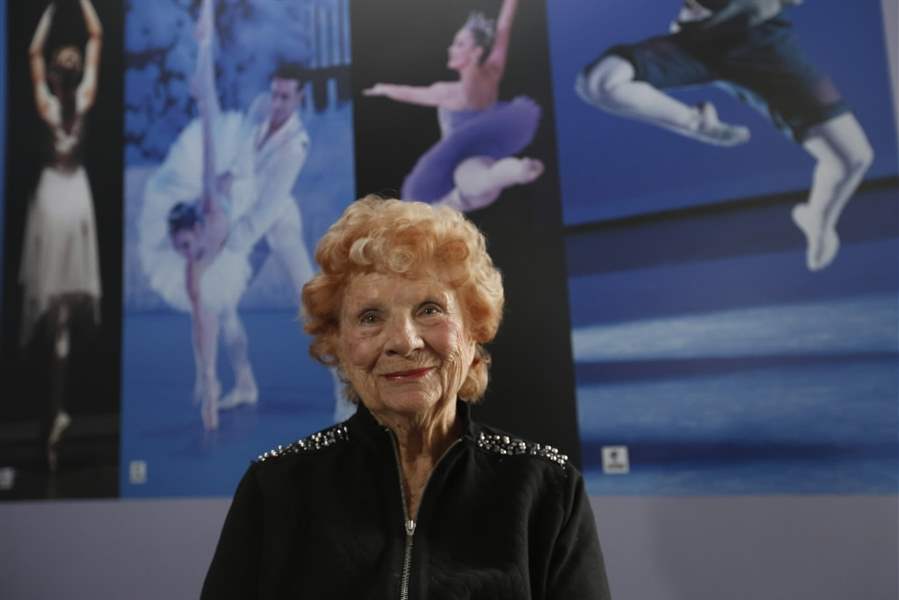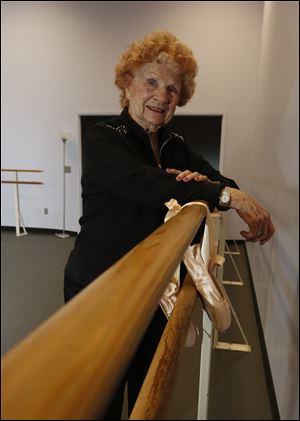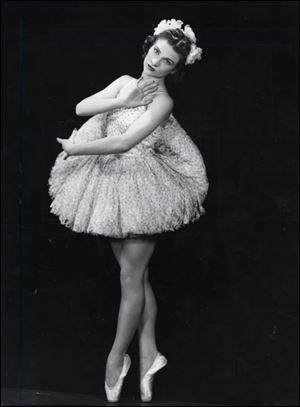
Toledo's Marie Bollinger Vogt to receive Governor’s Award for the Arts in Ohio
5/10/2015
Marie Bollinger Vogt is set to receive the Governor’s Award.
The Blade/Jetta Fraser
Buy This Image

Marie Bollinger Vogt, founder of the Toledo Ballet, in the studio last month in Toledo.
It has been 20 years since Marie Bollinger Vogt retired from the barre as the founder and longtime artistic director of the Toledo Ballet. Yet, her impact on the world of performing arts, in Toledo and abroad, still resonates today.
On Wednesday, the Ohio Arts Council will recognize her tireless devotion and leadership with the prestigious Governor’s Award for the Arts in Ohio in the category of Arts Administration.
The award is bestowed upon an individual who has shown long-term visionary leadership of an arts organization. Other local figures who have been cited with the honor include Robert Bell (1994), former president/CEO of the Toledo Symphony; Roger M. Berkowitz (2002), former executive director of the Toledo Museum of Art; and Marc Folk (2009), executive director of the Arts Commission of Greater Toledo.
“That [award] embodies the work that she has done for more than five decades. She established the Toledo Ballet in 1939 and for 55 years led the institution. That is remarkable in any day or age,” arts council spokesman Justin Nigro said.
The ceremony, held in Columbus, gathers members of the Ohio General Assembly and vanguards in the state’s performing and visual arts. It is held in conjunction with the state’s Arts Day, a day filled with events and programs that celebrate and recognize arts in Ohio.
Vogt’s award will be presented by Ohio Speaker of the House Cliff Rosenberger and Senate President Keith Faber. Ohio First Lady Karen W. Kasich will give opening remarks.
Throughout her career Vogt, who declined to divulge her age, has been showered with adulation and endless accolades. She said this is the capstone of her life’s work.
“This is just wonderful. It is the culmination of all the awards and attention. The next would be to make me president of the United States,” Vogt quipped.
Nominated by Toledo Ballet Executive Director Mari Davies, Nigro said Marie Vogt’s nomination was among those received from across the state. Each award recipient is selected by a committee seated by the art council’s board members and board members of the Ohio Citizens for the Arts.
Although he could not divulge the process of selection, he said Vogt’s “story was remarkable,” noting her service and devotion to the field.
“She built the ballet in a world of the late ’30s to present day. And managed to procure a Russian abridgment of The Nutcracker, during the onset of World War II and America still reeling from the Great Depression. It was an interesting time in our history,” he said.
A Toledo native, she instructed while she was still in high school. Two years after founding the ballet, the nation’s first performance of the The Nutcracker took place right here in Toledo.
“It is the oldest consecutive running of the production in our country. She ushered in a national holiday tradition. That is an amazing thing that an Ohioan had that influence across the country,” Nigro said.
Russia would not let Pyotr Ilyich Tchaikovsky’s full score out of the country in 1941. But the show went on in the Toledo Museum of Art with a partial score.

Marie Bollinger Vogt in this August 15,1940 file photo.
Vogt said in those early performances the dancers spirits were high, despite limited lighting and the absence of a world-class stage. Parents even chipped in by building some of the set in the backyard, she said.
“People came out for the arts. It increased the joys of the dancers, students, and parents as well, in spite of lack of food and lack of amenities. It was necessary that we have music and dance and the museum to fill the lives of our people here,” especially during the war years, she said.
She did not know at that time that performance would become a play synonymous with Christmas and all the sugary and sparkly delights of the holiday season.
“I just thought the music was beautiful and simple,” she said.
Little by little more of The Nutcracker score was released, and each year the Toledo production flourished. It has enjoyed a consecutive run for 73 years, making Toledo’s performance the oldest consecutive production in the nation.
With a well-rounded background in the arts, she found herself choreographer, instructor, and entrepreneur, and never once considered trading the instruction for the glory of the stage.
“I just enjoyed it so much I wanted to share it. Then it became a profession for me. Then it became a livelihood. Then people invited me to teach at their schools, such as the Bach Conservatory,” She said.
She credited her mother for her inspiring her interest in dance, the arts, and music. At age 7, to solve a leg ailment, her mother enrolled her in lessons to strengthen her muscles. Along with studying ballet at George Balanchine’s School of American Ballet in New York City, she has studied classical Greek dance, classical Spanish dance, and Flamenco. She also studied literature and Spanish at the University of Toledo.
As she was brought up to enjoy all the art cultures, so did she instruct her students.
“I tried to teach them to enjoy the music. So the dancing becomes the music. Even Balanchine said at ‘first it is the music. Then you want the audience to see the music.’ That is what the dancers do. they help the audience see the music,” she said.
Her pupils have gone on to open dance schools or instruct across the nation and in other nations, such as Canada.
As artistic director of the Toledo Ballet, she widened the audience’s world with memorable productions including Romeo and Juliet, Swan Lake, Cinderella, and A Midsummer Night’s Dream. With those productions came world-famous dancers.
She also went on to pen several books on dance and food, including The Businessman’s Ballet Book written “tongue-in-cheek.” It was written so that the men who donated money to the ballet or whose daughters wanted lessons would know what it was about, she said.
Her late husband, Theodore, supported her endeavors and had a love of words.
“He helped me a great deal with everything. His opinion was very much appreciated by me. And I did a lot of writing. His love of words was always instilled in me,” she said.
Davies said although she has only known Vogt for a decade, “I have known her forever. ... She is an icon in Toledo.”
“What she brings to this community is so rare. To have been such a young women in that time period, to venture out and start her own business. There were very few female entrepreneurs and that is what she was,” she said.
Vogt said that when she wanted to develop the Toledo Ballet at Cricket West on Central Avenue, she sought a loan. “I was told I would need my husband’s signature,” she said. The company moved to Franklin Park Mall in the 1980s and, most recently moved to a studio nearly double its size at 5327 Monroe St.
“One of the rooms is as large as the stage at the Stranahan. So the dancers can know the space where they will perform,” she said.
Besides her artistic talent, Vogt’s integrity and graciousness are admirable qualities, Davies said.
Vogt and Davies agreed that in the world of dance, teachers and pupils learn from each other.
“ ‘A true and honest thought that if you become a teacher by your pupils you'll be taught.’ And by your friends and associates you are taught,” Vogt said, quoting The King and I.
Contact Natalie Trusso Cafarello at: 419-206-0356, or ntrusso@theblade.com, or on Twitter @natalietrusso.